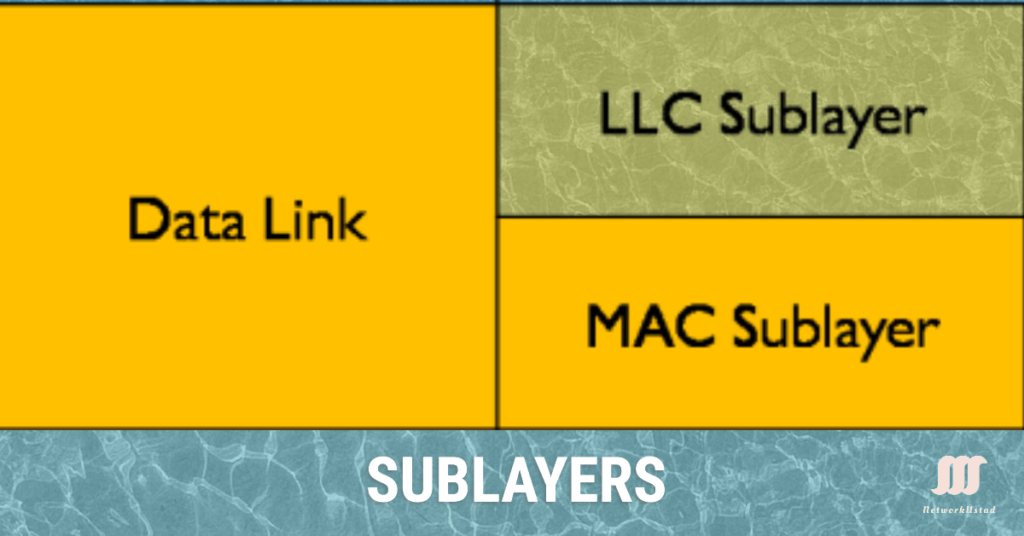In 2025, the Data Link Layer is critical for reliable network communication, enabling devices to transfer data efficiently across wired and wireless networks. Its two sublayers—Logical Link Control (LLC) and Media Access Control (MAC)—play distinct roles in framing, addressing, and error control. This guide explores their functions, differences, and relevance in modern networking, from Ethernet to Wi-Fi 7.
Overview of the Data Link Layer
The Data Link Layer (Layer 2 of the OSI model) ensures error-free data transfer between adjacent nodes. It’s divided into two sublayers:
- LLC Sublayer: Interfaces with the Network Layer (Layer 3), managing protocol multiplexing and flow control.
- MAC Sublayer: Interfaces with the Physical Layer (Layer 1), handling media access and frame addressing.

LLC Sublayer: Functions and Services
The LLC sublayer bridges the Network Layer and MAC sublayer, adding control information to deliver packets. Implemented in software (e.g., NIC drivers), it’s hardware-independent and supports protocols like IPv4, IPv6, and ARP.
Key Functions
- Multiplexing/De-Multiplexing:
- Multiplexing: Accepts packets from Layer 3 protocols (e.g., IPv6, ARP), adds protocol type to the LLC header, and forwards to the MAC sublayer.
- De-Multiplexing: Identifies the Layer 3 protocol from incoming frames and delivers to the correct protocol.
- Reliability (optional): Uses sequence numbers and acknowledgments to track and retransmit lost frames.
- Flow Control (optional): Manages sender speed via control frames (e.g., Receive Delay).
LLC Service Types
- Unacknowledged Connectionless Service:
- Best-effort delivery without connection setup or acknowledgments (similar to UDP).
- Rarely used in 2025 due to TCP/IP dominance, but applicable in low-overhead IoT networks.
- Acknowledged Connectionless Service:
- Sends frames without connection setup but with sequence numbers and acknowledgments.
- Common in wireless networks (e.g., Wi-Fi 6/7) for reliability over unstable links.
- Connection-Oriented Service:
- Establishes a logical link before data transfer using supervisory frames.
- Without Acknowledgment: Used in protocols like HDLC or PPP (less common in 2025).
- With Acknowledgment: Uses sequence numbers, acknowledgments, and sliding window for reliability and flow control (e.g., TCP-based networks).
MAC Sublayer: Functions and Responsibilities
The MAC sublayer, defined in IEEE 802.3, manages access to the physical medium and frame transmission. It supports technologies like Ethernet, Wi-Fi 7, and Bluetooth.
Key Functions
- Data Encapsulation:
- Framing: Adds headers (e.g., MAC addresses) and trailers (e.g., CRC) to Layer 3 PDUs.
- Addressing: Uses MAC addresses (48-bit unique identifiers) to ensure frames reach the correct device.
- Error Detection: Includes a trailer (e.g., CRC) to detect transmission errors.
- Media Access Control:
- Regulates access to shared media (e.g., CSMA/CD in Ethernet, CSMA/CA in Wi-Fi).
- Places frames on the medium and retrieves incoming frames.
| Sublayer | Key Functions | Protocols/Technologies | Layer Interaction |
|---|---|---|---|
| LLC | Framing, addressing, and media access | IPv4, IPv6, ARP | Network Layer |
| MAC | Framing, addressing, media access | Ethernet, Wi-Fi 7, Bluetooth | Physical Layer |
LLC and MAC in Modern Networking (2025)
The LLC and MAC sublayers remain vital in 2025:
- IoT: LLC ensures lightweight protocol multiplexing for low-power devices; MAC handles addressing in dense networks.
- Wi-Fi 7: MAC uses advanced CSMA/CA for high-throughput, low-latency wireless.
- 400GbE: MAC supports ultra-high-speed Ethernet for AI and data centers.
- 5G Integration: LLC/MAC facilitates backhaul and edge computing.
Conclusion
In 2025, the LLC and MAC sublayers of the Data Link Layer remain foundational to efficient and reliable network communication, powering everything from high-speed Ethernet to Wi-Fi 7 and IoT ecosystems. The LLC sublayer ensures seamless protocol multiplexing, optional reliability, and flow control, while the MAC sublayer manages media access, framing, and precise addressing with MAC addresses. Together, they enable robust data transfer across diverse technologies, supporting emerging trends like 400GbE, 5G integration, and smart devices. Understanding their roles is essential for optimizing network performance, making them critical for both professionals and enthusiasts navigating the future of connectivity.
FAQs
What is the primary function of the LLC sublayer?
The LLC sublayer manages protocol multiplexing, reliability, and flow control, interfacing with the Network Layer to deliver packets.
How does the MAC sublayer differ from the LLC sublayer?
The MAC sublayer handles media access, framing, and addressing using MAC addresses, while the LLC sublayer focuses on protocol multiplexing and error control.
Why are LLC and MAC sublayers important in networking?
They ensure reliable, efficient data transfer by managing protocol delivery (LLC) and media access (MAC), minimizing errors and collisions.
What is the role of the MAC address?
The MAC address uniquely identifies devices on a network, used by the MAC sublayer to deliver frames to the correct destination.
How do LLC and MAC sublayers support modern networks?
They enable technologies like Wi-Fi 7, 400GbE, and IoT by handling protocol multiplexing, media access, and error control.





